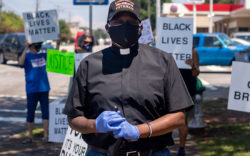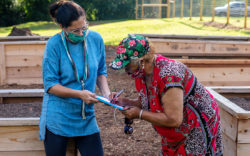The struggle among America’s people of color to fight for basic human rights, and the parallel challenge among whites to overcome their prejudices and accept that those rights have been granted, is certainly among the most arduous and hard-fought battles in U.S. history. Atlanta’s National Center for Civil and Human Rights is a relatively new cultural center that aims to document these battles with immediacy and drama and link them to the many human rights challenges endured by millions around the world.
First envisioned by civil rights veterans Evelyn Lowery and Andrew Young, the center sits next to (and shares parking with) the Georgia Aquarium and the World of Coca-Cola at the northern edge of Centennial Olympic Park. Three sides of the building form a continuous wide curve intended to suggest protective arms, and this long curve is made up of dozens of panels of different shades of buff and brown to suggest varied skin colors.
The principal exhibit is called “Rolls Down Like Water,” a reference to a Biblical quote Martin Luther King Jr. used in his “I Have a Dream” speech. Designed by the center’s creative director, George C. Wolfe, a Tony-winning playwright and director, the exhibit is a dramatic rush of information, a dense linear history crowded with photography, video, texts describing major events and interactive exhibits. Even though you may be aware of most of these events, you have never experienced them all in a single series of presentations, creating a powerful narrative of strength facing down fierce violence and hatred. Here you will find:
• An interactive replica of the famous lunch counter at the whites-only Greensboro, NC Woolworth’s. Headphones allow visitors to hear the vicious attacks that rained down upon protesters during a months-long sit in. Hearing the racist taunts is such a shattering experience that the center doesn’t allow children under 13 to experience the simulation.
• Antique televisions showing footage of segregationists speaking about race.
• Descriptions of the 1954 Supreme Court decision Brown v. Board of Education that declared segregated schooling unconstitutional.
• A presentation on King’s Nobel Peace Prize. Then-mayor Ivan Allen Jr. wanted to honor King by inviting Atlanta’s black and white elite to attend a gala dinner. When whites failed to respond, Allen reached out to Coca-Cola chairman Robert Woodruff, who was sensitive to Coke’s emerging image on the international stage and chafed at a New York Times front-page story about the surprisingly tepid response to the prize in King’s hometown. Woodruff and Coke’s CEO both exerted their powerful corporate muscle on the city’s elite, issuing a veiled threat of pulling out of the “city that’s going to have this kind of reaction and not honor a Nobel Peace Prize winner.” The city’s white elite quickly responded by snapping up 1,600 tickets.
• A large panel of photographs and text describing the Freedom Riders, a pivotal series of protests in 1961 that prompted howling mobs of whites to attack buses of black and white activists protesting the non-enforcement of a Supreme Court ruling that banned segregated buses and bus-station waiting rooms. The treatment of the protesters immediately drew international condemnation and helped inspire widespread participation in future civil rights campaigns.
• Four stained glass panels, each honoring one of the young girls who died in 1963 in the 16th Street Baptist Church bombing in Birmingham, AL.
• A dramatic multimedia presentation in which the Walter Cronkite report on King’s assassination appears on one TV screen, while another shows Robert Kennedy’s announcement of the assassination that drew cries and gasps at a campaign stop in Indianapolis.
• Other sections of the museum introduce us to the “Offenders,” despots of the 20th Century, including Hitler, Mussolini and Pol Pot, as well as the “Defenders,” victims of human rights abuses who tell their stories. Another exhibit displays some of King’s letters and papers.
The center also hosts numerous events, including lectures and readings. This summer, 30 students from the U.S. and Europe are participating in a program sponsored by the John Lewis Fellowship and the center for “for an intensive program about diversity and civil rights in America.”
As I concluded the main exhibit, I encountered three generations of a family who had met up in Atlanta. Terrence Keys, the father, described the exhibit as “powerful,” and went on to compare it to his visit to a concentration camp during a stay in Germany. “It reminds me of the way I felt when I visited Auschwitz,” he said. “It really pulls at your heart in the same way.”
Will the spate of cultural documents such as the center’s exhibits and movies on the civil rights movement such as Selma and 13th help influence continued progress? Athens educator and activist Mokah Johnson is hopeful, but also asked rhetorically, “How often do you experience injustices in a day? Not sure, because being racially profiled or judged due to race has become a normal way of life. It’s the way it is.”
Johnson went on to describe a recent teen pool party that her daughter attended at an Athens apartment complex pool where the police were called and the black attendees were asked to leave. Interestingly, she said the response among attendees was relief that no one was hurt or arrested during the incident. Clearly, the civil rights movement still has a lot of work ahead, and the center will be there to help guide and document the progress.
Like what you just read? Support Flagpole by making a donation today. Every dollar you give helps fund our ongoing mission to provide Athens with quality, independent journalism.










